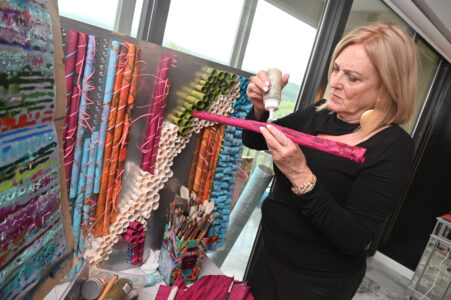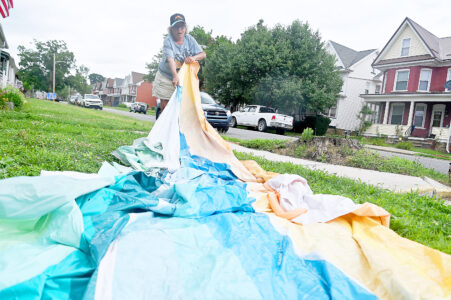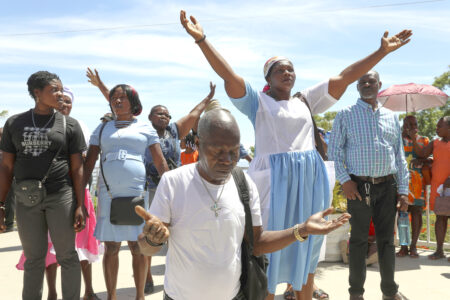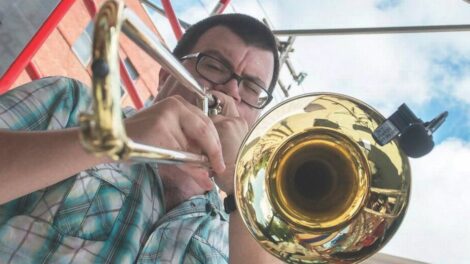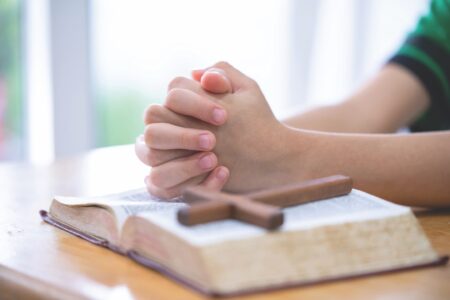Muslim charms tells a story: Juniata College loans religious relic to American Revolution museum

Mirror photo by J.D. Cavrich
Scott Stevenson from the Museum of the American Revolution (right) accepts a Muslim charm from Jonathan Burns, professor of archaeology and international studies at Juniata College in Huntingdon. The colonial-era charm was found by students at the Fort Shirley site in southern Huntington County.
HUNTINGDON — Smaller than a dime, the little charm easily could have slipped through the small excavation screens when Dr. Jonathan Burns’ archaeology students were digging south of here in 2010.
Instead of being buried forever, it’s making history.
Found in the dirt where the colonial era Fort Shirley once stood, the copper trinket is evidence that Muslims were in central Pennsylvania in the mid-18th century, said Burns, professor of archaeology and international studies at Juniata College.
A beaming Burns recently handed the Islamic copper charm to Dr. Scott Stephenson, vice president of collections, exhibitions and programming at the Museum of American Revolution (MAR), which is scheduled to open in Philadelphia next April two blocks from Independence Hall.
“It demonstrates the global reach back during the British Empire … right here in little old Huntingdon County,” Burns said.
“It’s incredibly rare,” Stephenson said.
The charm and a piece of its chain will join thousands of items in the museum’s growing collection that already includes a bust of George Washington, a silk flag that flew at his headquarters and the tent he stayed in while commanding the continental troops.
Stephenson said the Muslim charm specifically will go in a case dedicated to religion in Colonial Pennsylvania. Other items will include a pewter communion pitcher from George Whitefield, an 18th century Anglican cleric and one of the founders of Methodism; a 1743 weather vane from a Lutheran church; and, tentatively, a pair of rimonim, or finials for Torah scrolls that came out of a Philadelphia synagogue.
The charm will be hard to see.
It is just wider than 10 millimeters in diameter — less than a half-inch — and the skinny chain has only six tiny links. Burns noted that excavation screens used in the dig are 1/4-inch squares; the charm and chain could have slid through diagonally and been lost forever.
At the time of the dig, Burns was teaching archeology classes at Penn State in addition to Juniata College. He was leading the Penn State Archaeological Field School that was looking for Fort Shirley, one of four outposts built by the British after Gen. Edward Braddock was defeated at Fort Duquesne in the French and Indian War.
The British retreated east and in 1755 built a line of forts in present-day Huntingdon County. One was Fort Shirley on the site of fur trader George Croghan’s home and trading post — information that Burns confirmed from historical documents.
The fort was abandoned about a year after it was established. So finding the site 255 years later was almost like looking for a needle in a haystack. Burns said historians did have some old maps of the Kittanning Expedition that drove back the Delaware Tribe in 1756. But the diggers got tremendously lucky, finding the charm and chain in the plow zone of a test pit about 7 inches down — even before finding a wall of the fort.
“The charm was found … no deeper than 20 centimeters from the surface,” he said. “I had 16 students broken up into teams of two — so it was the luck of the draw who had the opportunity to recover the item. Kudos to them because the charm could have easily slipped through our screens, and to recover the delicate chain was a bonus.”\
It took several more seasons of digging before the crew determined that the charm has been found in the middle of the palisade, Burns said.
“It was a fortunate find,” he said. On private property, “that area had been hit with metal detectors for decades.”
One school of thought suggested the charm was costume jewelry from a female seminary in the area around the turn of the 19th century. But diggers also found other copper items that “looked like they had been in the ground for 250 years” with some oxidation, along with trade beads and other European items from the era, Burns said.
“I think it was there before the fort was built, but there’s some uncertainty” and could have arrived during its short occupation, he said.
Isotope testing shows that the copper likely came from a mine in Cornwall, England, he said.
“This makes sense since the preeminent trader and land speculator in PA was George Croghan, and he had direct access to goods and materials from England and Europe that were incorporated into Great Britain’s empire-building efforts,”Burns said.
But how did he figure out it was a Muslim charm?
Burns said one of his students from North Africa helped him determine that the writing was in Arabic. He went on to learn that the inscribed words are the English equivalent, “There is no god but God.”
“That represents the first pillar (of the five) of Islam, which is to declare the one and only Allah,” the Arabic word for God, he said.
Burns also determined that the decorative lettering is stamped on the copper, suggesting more than one was made using a diecast mold. And he went looking for them by asking experts.
“They kept saying, ‘Wow,'” Burns said. “They had never heard of one.”
He consulted, among others, Sylviane Diouf, an award-winning historian of the African Diaspora and a director of research at the New York City Library. She informed him that talismans and charms were used to connect enslaved individuals to Allah and to protect them.
“Although captives were often shipped across the Atlantic naked, small talismans could have remained in their possession,” Burns and fellow researchers Andrew Dudash and Ryan Mathur, wrote in a paper published in The Pennsylvania Magazine of History and Biography last month.
They already had confirmed that Croghan had slaves from Africa, based on a letter he wrote to British Gov. Robert Morris in 1755.
“It’s absolutely wonderful,” said Burns, who originally is from James Creek, about 15 miles down Route 26 from here. “Other than letters and written documents, there’s not much evidence of Muslims present in colonial Pennsylvania.”
Stephenson, a Pittsburgh native who graduated from Juniata College in 1987, said it was “dumb luck” that he was aware of Burns’ digs at Fort Shirley and another nearby colonial outpost, Fort Littleton.
He reached out to Burns earlier this year about the college loaning the charm to the museum. The parties agreed to three years with an option for an extension.
They also agreed that the charm’s value cannot be determined, even though they put a tag of $10,000 on it for insurance purposes.
“You can’t possibly know the value as it’s irreplaceable,” Stephenson said. “You have to have comparables to come up with a value.”
MAR will have a conservator study the charm and stabilize any corrosion, he said.
Burns said he hopes a museum visitor will spy the charm and say, “Hey, I’ve seen one of those” and shed more light on its mystery.
“A very small object like this is a launching point for discussion,” Stephenson said. “People will be asking questions about this for generations.”
They’re already talking about the museum’s centerpiece object: Washington’s headquarters tent. It was preserved for generations by Martha Washington’s family, including her great-granddaughter, Mary Anna Randolph Custis Lee, who had to abandon her Arlington House — and the tent — when her husband, Robert E. Lee decided to join the Confederacy during the Civil War. The museum tracked down that story of how the tent was preserved.
A circular stamp is on the inside of the tent made of linen, which was coming out of Egypt, a predominantly Muslim country by the mid-18th century.
“It appears to be a Quranic verse in Arabic script,” Stephenson said. “Somebody knew Arabic to craft that. It’s a very enigmatic stamp and another good reminder that there wasn’t just one type of experience of slavery in Colonial America.”
Mirror Staff Writer Cherie Hicks is at 949-7030.

